If you’ve lived in the Asheville area for any length of time, you know there are certain city roads that you simply avoid at key times of day. Prone to congestion, near misses and traffic accidents, thoroughfares such as Merrimon Avenue, Hendersonville Road, Patton Avenue and Tunnel Road can even be life-threatening for pedestrians, bicyclists and drivers alike.
And with tourism booming and more people looking to move here every day, traffic concerns on already crowded city streets loom large in the minds of many residents, as well as city and state officials.
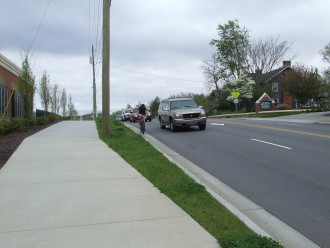
Xpress took a walk last week along the stretch of Merrimon between Interstate 240 and the crosswalk at the new light in front of Harris Teeter. We were joined by Don Kostelec of Asheville-based consultants Kostelec Planning, which specializes in implementing safe, efficient alternatives for pedestrians and cyclists.
During our walk, he pointed out a series of problems, including crosswalk-signal buttons placed in strange, nearly inaccessible places, and crosswalks featuring a handicapped-access curb cut on one side of the street but not on the other. We watched a man try to ride his bicycle south into the city, mere inches to spare between him and the cars speeding past trying to make the next light. We saw two pedestrians sprint across Merrimon at the entrance to Greenlife Grocery to get to the bus stop, rather than walk some 50 yards downhill to the nearest stoplight-controlled crosswalk.
“In theory, yes, those guys should have walked the 150 feet to the crosswalk, but many people just don’t think that way. We wouldn’t ask drivers to go out of their way; why should we expect pedestrians to do it?” says Kostelec. “People are going to follow their natural inclination to take the most direct route to the bus stop.”
No refuge
Indeed, human nature plays a role in many of the incidents along Merrimon and other major roads, particularly when those thoroughfares’ carrying capacity has been reached or exceeded. “Merrimon Avenue serves approximately 20,000 motorists a day on a four-lane road through concentrated residential and commercial areas,” notes Anna Henderson, traffic engineer with the N.C. Department of Transportation’s Division 13, which oversees state roads running into and out of Asheville. “Four-lane highways like Merrimon, with no median strip or designated turn lanes, are particularly dangerous because they offer pedestrians no refuge area to pause in,” she explains.

Like many public agencies in Buncombe County, the DOT has had to try to accommodate both a rapidly growing population and changing patterns of commerce, as new grocery stores like Harris Teeter and Trader Joe’s on Merrimon have drawn increased vehicle and pedestrian traffic to the already crowded road.
The developers of both stores were responsible for submitting traffic-flow plans and traffic-control improvements to the city and state for approval. According to Jeff Moore, a traffic engineer for the city, the developers of Trader Joe’s were required to incorporate Harris Teeter’s traffic study — which was conducted first — into their own study prior to construction.
“We have seen an increase in vehicle traffic and pedestrian accidents over the last few years,” says Henderson, adding that the DOT plans to re-evaluate several intersections along Merrimon later this year.
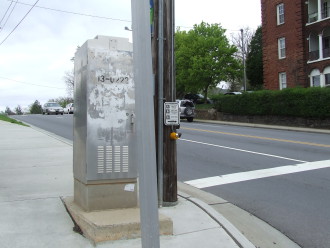
East Asheville resident Nick Neubauer drives Merrimon Avenue daily on his way to work. “A turning lane would solve a lot of the traffic problems, but there isn’t any room for one,” he muses, mentioning several sections along the stretch between Beaver Lake and downtown. “The traffic light timing could be adjusted, but travel speed [varies] between 10-35 mph depending on time of day, so there’s no good approach there either.”
The busy road’s shortcomings came to a head this past January, when 67-year-old Yvonne Lewis of Arden was struck and killed by a motorist while trying to cross Merrimon at the Coleman Avenue intersection. The fatality sparked demands that state and city officials address trouble spots along the busy road.
Asheville City Council member Chris Pelly, whose concern for pedestrian safety helped fuel his entry into public life, blames increased population and business density, coupled with inadequate pedestrian infrastructure.
“Merrimon is a four-lane road, which makes left turns difficult,” says Pelly. “It also has numerous driveway cuts, which increase accident rates.”
He compares Merrimon’s evolution with the intense development along Hendersonville Road (including several large apartment complexes) and Patton Avenue (the main link between Asheville and Leicester). But while both those roadways have been widened, the lack of room for expansion along Merrimon poses a unique challenge for engineers and planners.
NC’s most dangerous city
The city and DOT coordinate their planning through the French Broad River Metropolitan Planning Organization, whose goals include increasing options for pedestrians and cyclists, Pelly points out. Recent improvements initiated by the agency, he notes, include sidewalks along Tunnel Road in Oteen and along Patton Avenue at Bowen Bridge.
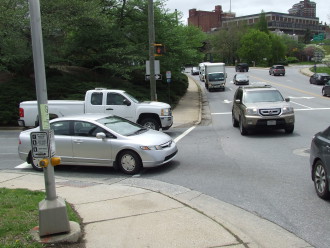
Last year, residents lobbied for sidewalks on Hazel Mill Road (see West Asheville Apartment Plan Highlights Pedestrian Safety, Dec. 1, 2014, Xpress). City Council recently allocated $15,000 for those sidewalks.
And in the wake of Lewis’s death, the DOT has placed a high-visibility crosswalk at the intersection of Coleman and Merrimon and plans to install a new traffic signal and crosswalk there this summer. Other projects are scheduled for the fall.
The city also gets input from its Neighborhood Advisory Committee, consisting of residents, Police Department representatives and city engineers, who are charged with identifying traffic problems and advising residents on ways to deal with them.
But with the upcoming tourist season promising to be bigger than ever, Kostelec, Pelly and others fear that Asheville’s glaring traffic problems are likely to get worse before they get better. “Tourism will certainly increase the amount of traffic, especially downtown,” Pelly predicts.
Jim Grode, who chairs the city’s Multimodal Transportation Commission, goes further, noting that “In terms of pedestrian traffic accidents, Asheville is statistically the most dangerous city in North Carolina.” The commission educates and advises city officials and the public on transportation issues, including initiatives to develop efficient, safe multimodal systems.
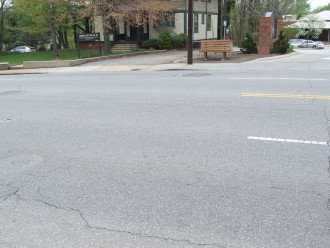
From 2008-12, Asheville averaged 8.1 pedestrian accidents per 10,000 people — well above the average for North Carolina’s biggest metro areas, and increasing each year during that period — according to a DOT report. Such statistics, says Grode, are challenging city and state officials to change the way they think about transportation.
“No matter how you’re getting around, we want to make your trip safe, pleasant and efficient from a broader standpoint,” he continues. “Efficiency doesn’t mean moving as many cars as you can as fast as you can from one place to another … with no regard for whether the people actually need to go that fast or should be moving that fast.”
Multimodal planning
Established in 2013, the commission is supposed to work with city and DOT officials to develop a multimodal transportation plan for Asheville, though Grode says the details of that cooperation have yet to be hammered out. The city will release its plan by the end of this year, Grode reports, saying that he expects it to include short-term solutions to traffic problems while highlighting longer-term structural issues and proposing fundamental changes to the design and function of Asheville’s roadways.
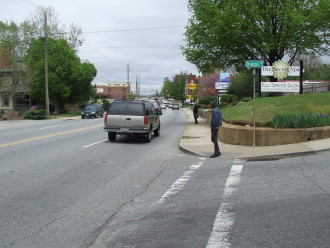
“We need to get away from thinking about transportation and traffic as an end in itself,” says Grode. “That’s my biggest goal: Let’s stop thinking about transportation like it’s in this vacuum, something we’re doing purely for its own sake.”
Kostelec agrees, calling for “traffic dieting” on Merrimon — converting an existing through lane into a left-turn lane to make traffic flow more predictable — as one of several alternatives that have proven successful in other cities.
Pelly, too, supports that idea. “Traffic calming can slow vehicles and improve the safety of residents,” he says, adding, “For the first time in eight years, last year City Council funded traffic calming, which brought needed improvements to Bear Creek Road and Riverview Drive.”
But whatever plans the various agencies develop, the real challenge will be getting those projects funded, designed and completed. “These things may be feasible within the next few years or the next few months,” says Grode.
The DOT, says Henderson, recognizes the need to re-evaluate pedestrian infrastructure along many state roads in response to simultaneous population and traffic density increases. The agency, she says, is “working to find appropriate and safe crossing treatments” along the busy thoroughfares to better accommodate pedestrians.
Interim measures
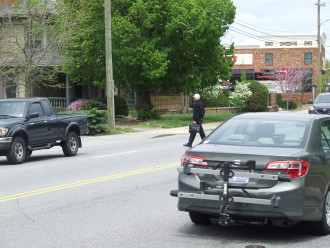
In the meantime, though, there are practical measures that officials and residents alike can take to reduce the risks along Asheville’s busy roadways, notes Grode.
Things like “re-signaling, re-timing traffic lights and crosswalks” and placing temporary ramps along sidewalks until curb cuts can be installed, he says, “are easy, quick fixes.”
For its part, the DOT advises pedestrians, cyclists and drivers on or near major roads to stay vigilant, urging them not to assume that they know how others will react. Watch for Me NC, a statewide campaign administered in cooperation with UNC Chapel Hill’s Highway Safety Research Center, aims to educate residents and public agencies on safe transportation practices while advocating law-enforcement crackdowns in accident-prone areas.
But Kostelec and others maintain that government agencies tend to place the burden of safety on pedestrians without adequately considering the socio-economic realities and often inefficient infrastructure found in working-class neighborhoods. Kostelec has conducted his own analysis of pedestrian crash rates in Asheville from 1997 to 2012 based on racial background, but correlating those numbers with economic information, he says, is more challenging.
“It’s a lot easier to tell if somebody hit by a car was white or African-American than it is to tell how much money he made,” says Kostelec, who concedes that people can do more to protect themselves, such as using designated crosswalks when possible, and not texting while driving or walking. He also recommends simply slowing down when driving on Merrimon and other busy streets.
“You’re seven times more likely to be killed by somebody going 35 miles per hour as you are by somebody going 25,” says Kostelec. “Ten miles per hour makes a big difference.”

Grode, meanwhile, stresses the importance of improving local infrastructure, rather than always looking to major roads to solve traffic problems. “If you’re going 10 miles an hour for a mile, you’re still getting there faster than if you’re going 50 miles an hour for 15 miles,” he points out.
One thing just about everyone seems to agree on, however, is that fixing the inherent issues on Merrimon and Asheville’s other main arteries is a significant challenge that will take time, creative approaches and involvement at all levels, from residents on up.
“You never treat cancer by giving someone an aspirin and saying, ‘There, now your pain will go away,’” Grode observes. “But that’s kind of what we do with traffic — and that needs to change.”
For more information visit watchformenc.org or attend the Multimodal Transportation Commission’s monthly meetings (3 p.m. every fourth Wednesday in City Hall’s first floor conference room). To view maps showing daily traffic volume for Asheville and Buncombe County, go to ncdot.gov/travel/statemapping/trafficvolumemaps/



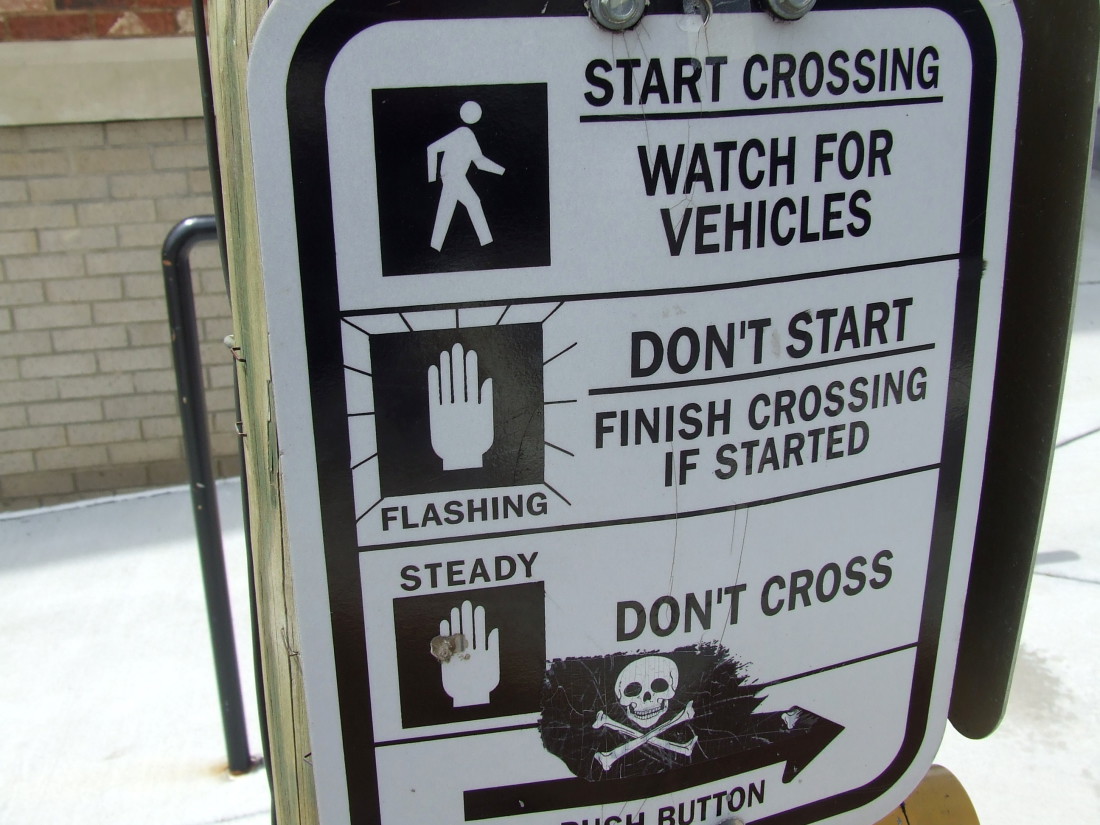
I travel on Merrimon regularly by car, bicycle and foot. It’s nightmarish in all modes of transportation, but especially scary on bike or foot. Sidewalks are broken, narrow and sometimes non-existent. Where there is a sidewalk, it is so close to the roadway, walking them is still nerve wracking. To make matters worse, the sidewalks typically have utility poles right in the middle of them, narrowing your path even more. These poles are scarred from being hit by cars regularly; several times I’ve seen it happen. Will it be a pedestrian next?
As a cyclist, since there is essentially no bike lane, or even a shoulder, there is no choice but to “take your lane” when going uphill, and thereby anger drivers around you – risking a bullet to the head (https://mountainx.com/news/community-news/former_asheville_firefighter_gets_4_months_for_shooting_cyclist/).
I live almost exactly 1 mile from where my wife works on W.T. Weaver Blvd. but there is no reasonably safe, direct and convenient way to get there and back by bike or foot. As a result, we are 1 or 2 more cars on the road, congesting it even more, just to travel 1 mile; all while I would happily walk or ride if it were safe, direct and convenient.
Finally, the comment in the article about traffic speed varying on Merrimon is kind of funny. Yes, it’s true that the speed varies, but I’d put it more around 10-50mph.
Thank you for offering your perspective on Merrimon and some of the issues commuters of all varieties face, Lance. I too used to commute twice daily on Merrimon, and can relate to much of what you’re saying. I’d often drive to work around 5:00am, and back around 3:00pm, and the difference between traffic in the AM and the afternoon was (literally & figuratively) night and day. I do know that the city and NCDOT are looking at Merrimon very closely to address some of these issues, but as you alluded to, there’s just not much existing space to work with.
I’ve noticed the utilities poles as well. Scary stuff. Hopefully the powers at be will be able to work together and pull resources to come up with alternatives that do provide the “safe, direct, and convenient” route you spoke of. I know that there’s alot of people working towards that goal. The challenge now is implementing it.
Max, thank you for reporting on this! I have a couple of follow up questions you may know the answer to. I’m curious about the utility poles. Is there any effort that you are aware of to bury the phone/cable/electrical lines along Merrimon? And what about sidewalks. I know that Merrimon is state owned and managed by the DOT, does that mean that sidewalks on the roadside fall under their purview as well?
Thank you for taking the time to read and respond, Lance! I’m glad to hear there are other people interested in this topic and discussion. Good question about the utility poles! I’m not aware of any direct effort to address or reduce them, though I’m sure that will be one of the many aspects of Merrimon being evaluated by NCDOT this year. With so many pressing issues in regards to Merrimon, it’s hard to speculate on how high on their priority list burying the lines would be. It would certainly be a beneficial measure, but I imagine somewhat labor/time-intensive as well. But again, I have no direct knowledge of that.
As for the sidewalks, I believe that they do fall under NCDOT’s jurisdiction, though again that may be one of those grey areas the city and state are attempting to figure out. I do know that when Harris Teeter and Trader Joe’s were constructed, it was the responsibility of the developers to conduct studies and design a plan for the new sidewalks installed there. I imagine that policy would extend to any new business along Merrimon or other roadways.
However, since said developers were only responsible for their property, the results were some of the issues mentioned in the article, specifically upgrades to new crosswalks on one side, but not on the older, existing side opposite the new construction. NCDOT will be evaluating such occurrences as part of their overall survey of Merrimon this year.
Questions & comments for the author of the article RE: “curb cuts”
To begin with, I never knew the correct term for what those are called, so thank you. I’m curious about these curb cuts; both their presence and their absence.
I too have noticed the absence of curb cuts in many places around Asheville (not just on Merrimon Ave.) I think the absence of these is relatively easy to explain — they just never were installed, whether for lack of funding/manpower, accidental oversight, etc. Many reasons could contribute to the crosswalks that are lacking curb cuts.
On the other hand, I have noticed something else inexplicable regarding curb cuts around Asheville. There are many places (10’s at least…perhaps even approaching 100) with curb cuts that lead nowhere whatsoever! Seriously. A curb cut that is attached to no sidewalk. In some places lines are painted on the street for the crosswalk that connects 2 curb cuts, but there’s nowhere to walk once you get to the other side!
So my question is: Why are there curb cuts with no sidewalk in some places around Asheville? Who approved such nonsense?
Just so you don’t think I’m exaggerating, I’ll tell you where to look for an example — the intersection of Tunnel Rd. and Beverly Rd. in East Asheville. On the southeast side of the Tunnel Rd. there are 2 curb cuts. One of them has a pretty great looking painting of a lion fountain. The curb cut with the lion painting leads nowhere except to the other useless curb cut (or back to the opposite side of Tunnel Rd. where the sidewalk actually is). Why are curb cuts like these ever even built? Taxpayer money wasted. Note: these are not the worst example of a useless curb cut…just the ones that came to my mind first as they are highly visible. There are plenty of others that are equally, if not more, useless.
Thanks for you comments and inquiries, Ashevillian7. Good question! I personally can’t speak to why curb cuts exist in one place and not another, though I think you are on to something in respects to funding & oversight. One thing I did learn while researching this article that I believe may play a part in this who has jurisdiction over certain roads.
In the case of Merrimon (and Tunnel for that matter), those roads are maintained by NCDOT, which is a state agency. Asheville City roads, however, are the city’s responsibility, and I got the sense that there was some tension/bureaucracy involved with who is responsible for what, who pays for improvements, and what the issues at hand are. This is something I believe groups like MMTC and FBRMPO are working to correct and streamline the process, as well as improve dialogue between these various agencies.
That said, I know exactly which area you are speaking about on Tunnel. The appearance of curb cuts there may have something to do with access to nearby bus stops, or perhaps in anticipation of future sidewalk additions, but again, I’m speculating on this. I definitely see your point though: they do appear random at times, and I’m not sure how helpful they actually are at the moment.
In the specific area I studied for this article with Mr Kostelec, it would seem that while the sidewalks in front of Harris Teeter were built to accommodate increased foot traffic, the other side of the road, where sidewalks already existed, were not factored completely into the upgrades.
First, thanks for taking the time to read and respond to the posts here. Nice work.
Second, just one more note about curb cuts. I do see that the curb cut where the lion painting is does have a bus stop. That totally makes sense now. However, I still maintain that there are numerous curb cuts that are unnecessary and unused. Some of them are starting to deteriorate. Check out the curb cuts at the intersections before and after Beverly Rd. The intersections at Sherwood & Tunnel and Huntington & Tunnel. 4 curb cuts that look like they’ve never been used. This is just on one 1/4 mile stretch of road.
I wish I had more free time. I would love to go around the city to take inventory and photograph these useless curb cuts. Many of them (such as the ones on Huntington) are so useless that there is nowhere to even put a sidewalk at all. This stinks of pork barrel spending (not an accusation mind you, just the impression that I get). This seems to have flown under the radar for a number of years so I’m guessing that not many people are concerned about how their tax dollars were used here or who profited from this venture. I would love to get an answer from the city or the DOT as to why these were built. Maybe an intrepid reporter would be interested in a follow up story?
Thanks for the follow-up, ashevillian7! I appreciate you and everyone on here creating a dialogue around this topic; these are the kind of discussions people need to be having with the city and state DOT if things are ever going to improve on roadways.
I definitely agree that those curb cuts without any noticeable reasoning behind them are odd, and would have to ask DOT or the city as to the reasoning behind them. I do plan on following this story further, and will keep that in mind the next time I speak to somebody who may know the “whys” behind that.
For clearer answers on this question and others, or to simply voice you opinions or concerns about this topic, I encourage both of you (and anybody else) to attend one of the MMTC’s monthly meetings (every 4th Wednesday of the month, 3pm at City Hall). I’m sure they would find your feedback very valuable to their efforts. Also, check out the Neighborhood Advisory Committee (http://www.ashevillenc.gov/Departments/CityClerk/BoardsCommissions/NeighborhoodAdvisoryCommittee.aspx) or watchformenc.org for more info on what you can do to get involved in correcting traffic problems, or contact city and state officials.
The absence of left turn signal lights at many intersections on Merrimon Ave. is absolutely mind boggling. With the heavy increase of traffic on this road and new businesses popping up all the time, it seems that the traffic dept. has not kept pace with demand. The roadway from downtown to Beaver Lake has become a very dangerous race track during periods of heavy use. I expect to read about more fatalities in the future,, unless some serious corrective action is taken soon. Traffic light times are too long all around Asheville allowing long lines of cars to build up, which leads to more congestion. The lack of traffic light synchronization on Asheville’s main arteries is also a source of great concern.
I both drive and walk the section of Merrimon Avenue between Hillside and Coleman almost daily, often cross Merrimon on foot, and deem it very dangerous. I have had many opportunities to observe how this street works, and have a concrete suggestion on how to tame this and other similar sections of street in Asheville. First, I will note that it is four lanes wide (obviously) and each of these lanes is ten feet wide. It’s forty feet almost exactly (I paced it while crossing, at 2.5 feet per step). Its width encourages cars to speed ( many are ten miles over the limit or more) and a vehicle can pounce upon a pedestrian from nearly a hundred yards off in the time it takes to cross those forty feet. Many drivers will not slow down for a pedestrian. I have observed that it’s much safer when one of the lanes is being dug up! The cars slow down and you only have thirty feet to safety.
Now, a bit of data: according to a study published last June in Wired, “Building Bigger Roads Actually Makes Traffic Worse”. Link: http://www.wired.com/2014/06/wuwt-traffic-induced-demand/
Quote: “If a city had increased its road capacity by 10 percent between 1980 and 1990, then the amount of driving in that city went up by 10 percent. If the amount of roads in the same city then went up by 11 percent between 1990 and 2000, the total number of miles driven also went up by 11 percent. It’s like the two figures were moving in perfect lockstep, changing at the same exact rate.”
It seems that people adapt their driving habits to a set level of congestion; drivers will use extra capacity until a certain threshold of inconvenience makes them avoid driving unless they must…
Again, from the article: “Interestingly, the effect works in reverse, too. Whenever some city proposes taking lanes away from a road, residents scream that they’re going to create a huge traffic snarl. But the data shows that nothing truly terrible happens. The amount of traffic on the road simply readjusts and overall congestion doesn’t really increase. For instance, Paris in recent decades has had a persistent policy to dramatically downsize and reduce roadways. “Driving in Paris was bad before,” said Duranton. “It’s just as bad, but it’s not much worse.””
So, within limits, we can actually take away some road capacity without making the situation worse! And we should… The DOT can do this on Merrimon with little more than paint!
The section in question (and perhaps some similar ones in places like Patton Avenue and Tunnel Road) is presently four travel lanes, two northbound and two south. Drivers wishing to turn left often must stop dead until an opening appears in the other direction, leaving a line of cars sitting behind them.
The change: Repaint the lines. New scheme: One travel lane northbound, one southbound, one turning lane in the middle, and the remaining ten feet of width to be given over to bicyclists and pedestrians. The outermost three feet on each side should be a marked bike lane, off limits to drivers; this leaves four feet in the middle for pedestrian refuge, and I wouldn’t mind seeing a chicane every now and then. Something like this already exists on Broadway out toward UNCA. Many streets in Portland, OR are put together in much this fashion, and when I visited there I noted a profusion of people riding everywhere on their bikes, when they might otherwise have taken up four times as much road in their cars.
That’s what’s needed here. Good design makes it easy for people to do the right thing.
I came up with the same scheme years ago for both Charlotte St. and Merrimon Ave… 2 car lanes, 2 bike lanes, 1 turn lane on each of those roads and encourage higher speed thru-traffic to use Broadway, which is designed to handle the traffic better than either Charlotte or Merrimon.
One change to this that I’ve been thinking about lately is instead of having the bike lanes on the same level as the cars…just widen the sidewalks to use the portion of street that would normally carry the bike lane. It’s legal in NC to ride bikes on sidewalks, plus doing something like this would allow pedestrians a better sidewalk to walk/run on. I frequently see walkers/runners using the bike lane on Kimberly and elsewhere but it’s not safe to have the pedestrians at the same level as the vehicles.
Unfortunately my schedule is such that I can not attend these meetings and propose these changes to anyone who matters. If you can make it, please do!
Thanks for posting this article, Tom! Your suggestions are very much in line with what Mr. Kostelec and others spoke of when referencing “traffic dieting”, which is the purposeful restriction of roadways to make traffic more predictable and set clear boundaries for motorists, pedestrians, and cyclists. It essentially seems to become a matter of compromise: Do we want to focus on volume or coherence & safety when it comes to traffic on city and state roads?
This is one of the many ideas being factored into the upcoming studies by the city and NCDOT, and hopefully there will be a clearer vision of what’s to be done by the end of this year.
Yes, I like this idea too. It would be nice if this pattern extended from I-240 to Beaverdam Rd. Building a bigger road here is not feasible, and won’t solve the problem, since traffic will always grow to fill existing roadways.
I am of the opinion that infrastructure around Asheville is woefully lacking. Our state and local leaders have repeatedly sold us a bill of goods based on misinformation and ignorance. Time and time again our administrative officials have promised working solutions to adding commerce and residences to areas that are already beyond the capacity of their current infrastructure in the form of band aids on gaping wounds. This lack of, A) correct analysis of severely overburdened infrastructure, B) lack of commitment to planning and growth, C) lack of commitment to serving constituents in need of solutions to societal transportation needs, has left our city with the paved horse and buggy trails that were established for traffic patterns and usage in the early 1700s. At no point in the intervening 200 years has any city or state official done anything to incorporate the transportation changes that have become our current reality. Infrastructure planning requires forethought unseen and unknown in this city and state. We, as citizens, must also realize that the infrastructure that is needed will cost money. It seems to me that we eskew any thought of paying taxes without realizing that societal issues can only be adequately addressed by viable solutions which entail cost. Apparently, the electorate in and around Asheville prefers to sit in traffic and waste energy resources and time while making pollution.
I have lived in Asheville for over thirty years after having lived all over the “free” world prior to settling in Asheville. These are, almost without exception, the same exact roadways and traffic configurations that existed thirty years ago. The only exceptions of note are the addition of some speed bumps and traffic islands (obstacles to safe driving) in the middle of already undersized and inadequate roadways. Actually, I have witnessed the removal of more driving infrastructure to the implementation of these “improvements” than has been added to accommodate increased volume and usage. Also, thirty years ago, Asheville was in a much more bleak economic situation than it is today. Thirty years ago, Asheville’s neighborhoods were on the decline and commercial real estate sat vacant and unused in those days. Today, neighborhoods are thriving and growing and an empty business address downtown is nearly impossible to find. Our population has grown and our tax base has grown. I have an impossible task in trying to understand why our city, county, and state keep trying to tell us that they can’t afford to administer to the needs of the society within their gerrymandered bounds. Even the most recent changes (I haven’t personally seen any “additions” in many years; when are we getting that I-26 connector?????? That has been “under consideration” for over thirty years……) were already obsolete before the asphalt and concrete dried. Six lanes between Hendersonville and Asheville??? Shoulda been ten……. Why do our elected officials consistently under perform and disserve us? Where is the money from our increased tax base going? Why are the “solutions” they offer us so inadequate? And why do we accept “solutions” that they advise, which most often prove inadequate to serve the purposes of a busy, growing city and county. Because we allow mediocrity and insufficiency in our government. Our government is preoccupied with attempting to tell us how to live our lives rather than providing things like infrastructure for our tax-paying society to use or teachers and supplies to educate and inform our future (traffic engineers)…… North Carolina, Buncombe County, Asheville; how your state, county, city and neighborhood are governed and administered is up to YOU!! Vote Smart!!
Thanks for your perspective as a long-time resident, Traveller. I think you hit the nail on the head in reference to the changes from the past to present, and the difficulties in keeping up with a growing population.
I’m not sure that I would say that city and state officials are willfully misleading the public in regards to traffic issues; it seems that the issues center more around what you touched on in regards to available money for upgrades, i.e. tax money. NCDOT also is responsible for maintaining the interstates as well as state roads, which places a huge burden on their resources. There is also the matter of topography and the physical landscape of our region to consider. Much like the issues the housing industry in WNC is facing, there’s just not much room left to develop or redevelop, which forces city and state officials to get creative in how they approach roadway upgrades and expansion (not necessarily a bad thing in the long-run).
I would definitely encourage you to voice your opinion at one of the public forums or meetings mentioned above! As you said, improvements can only occur if residents are committed to being part of that process.
Dearest Max,
I appreciate your response and the fact that you have chosen a career that helps to facilitate public discourse; you and your employer earn respect in that aspect of your chosen public endeavors. I tip my hat to you and to Mountain Express!!
Any aspect of societal concern is a balance between many, at times opposed, positions. Housing, like traffic engineering, is a societal concern requiring intelligent, highly educated and professional administrators to manage with any efficiency at all. My observation is that, far too frequently in our local governance, “leaders” spend too much time and energy in our private lives and far too little time and energy on issues involving our entire society. In any case, my point is this – societal planning is built into legal framework. Legal framework in this region is far too concerned with moral and immoral legislative efforts resulting in a legal framework that is inefficient and ineffectual far too often. Why is the local “public utility” energy company operating a “for profit” company without competition that abuses its customers and pollutes the environment in our region with seeming impunity? Again a public concern regulated into private, for profit interests instead of serving the public? Our legal structural framework is archaic, inefficient and ineffectual because we all want to look at trees instead of forests…. The smoke and mirrors our leaders offer us as disguises for solutions aren’t serving to make our city and region a better place to shop, live and work. Sidewalks, roadways, housing, education, business practice and regulation are decided by the people that we send to represent us in societal concerns. Those friends of ours, the neighbors that we send to city hall and the commissioner’s board room, to Raleigh and to Washington have failed to recognize that solutions for concerns such as traffic management are the very kinds of things that they were hired to work out for their neighbors back home. There are numerous dangers inherent in our roadways that lead to property damage and personal injury every day; the damage done by an unplanned, haphazard amalgamation of livestock trails and horse and buggy paths. A lack of vision for the future and desire to maintain political control has hindered our leader’s efforts shamefully and made it impossible for them to accurately assess the realities in our neighborhoods and on our city streets, much less improve them. Back to I-26; do we realize that Tennessee discussed, planned, and built their section of I-26 from Johnston City westward to the state line in less time than our local and state leaders have wasted simply discussing our portion of that roadway? Yes; we’re looking good from Mars Hill to the state line, but those of us that live north of Asheville can speak to the inadequacies of the roadway from Mars Hill to Asheville, not to even whisper of the confusion and danger of attempting to make transitions to points east and south of Asheville once you get to where our connector is supposed to be.
The happenstance existence of ancient stock trails, meandering waterways, hills and valleys does not create a transportation system worthy of the population and growth needs of an ever-expanding society and it never has.
Let’s scrap our outgrown perspectives and roadways, our inadequate housing laws and discriminatory business practices and take a fresh look at the nuts and bolts required to build an efficient society.
If the next politician you listen to is talking about what’s happening between your ears, or in your heart, or in your bedroom, and not about what is happening in our schools, on our streets, and in our neighborhoods, then tune them out and look for somebody that has a proven record of knowing about that of which they speak. Look for solutions, not inflamed passions…. We’ve missed a lot of opportunities in our region to improve our lot in life because we can’t agree on issues of mutual concern. Can we elect a government, any government, that can make some progress on these seemingly intractable concerns?
THAT is my urgent desire; that our political leaders get busy with the business of finding and implementing viable solutions instead of behaving as though they are on a pleasant drive along one of our ancient, meandering roadways. Reduce waste and repetition, create positive change and working solutions right away; administrative and political paralysis exists at all levels and in all domains of our governance. Let’s work together to improve our roadways and our region.
I don’t own a car, so I get around Asheville via bicycle, walking and the bus. If most Ashevillens were given just a taste of what it’s like to be a pedestrian in this city, there’d be a revolution. But, since most people get around in their little protected bubble, it’s only the less affluent that face the dangers of crossing streets, walking on sidewalks and bicycling on narrow roads. Honestly, I think all of us need to come together on this issue.
How can you call for “all of us to get together on this issue” after YOU just insulted every one of us who drive a car by referring to us as those who “get around in their little protective bubble”.
That is like saying “screw you”, then “let’s be friends”.
I was speaking to my fellow pedestrians. And, BTW, I still drive and I know what it’s like being in a car. It is a bubble and you do view others as a nuisance.
I think there are faults on both sides of the table, based on my personal observations. Drivers can most certainly be a little more patient and cautious, but pedestrians can also be more aware of what’s going on around them before stepping into the street, and using crosswalks when its possible (though that is a whole issue in itself)
The difference, obviously, is that a pedestrian is much more likely to suffer serious/fatal injuries as a result of a collision than a motorist is (not to say motorists don’t run the risk of injury either). My understanding is that this lends credence to those who believe that traffic needs to be simplified and more uniform along Merrimon and other roads, instead of focusing strictly on increasing volume.